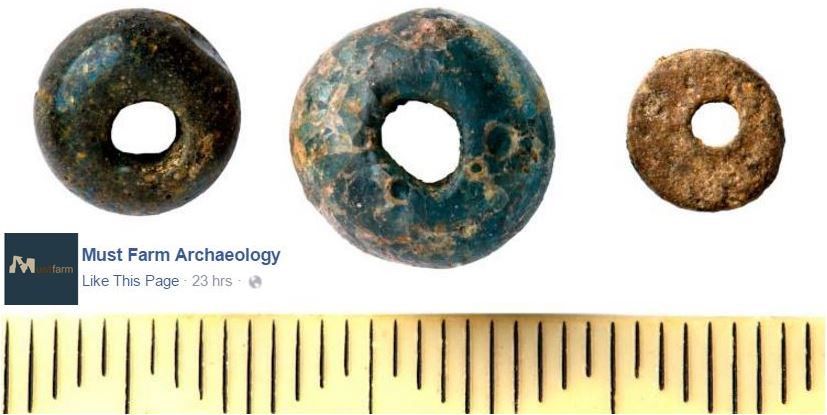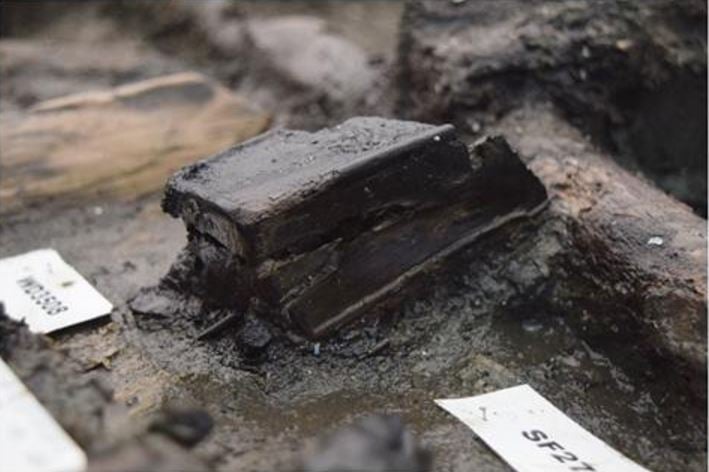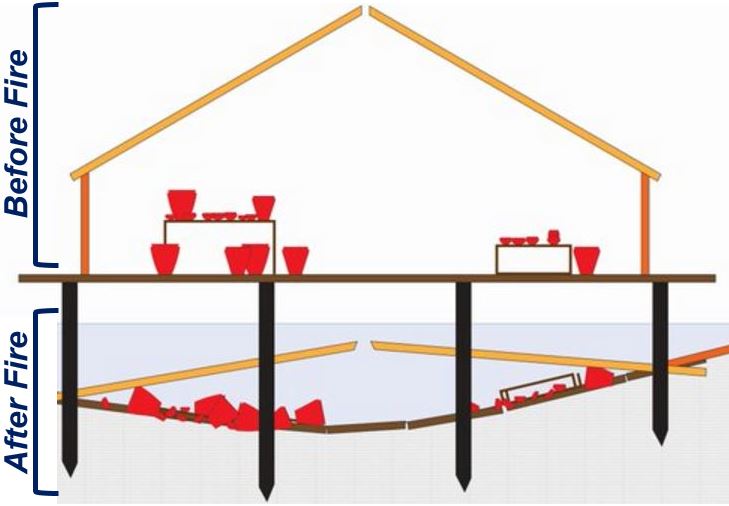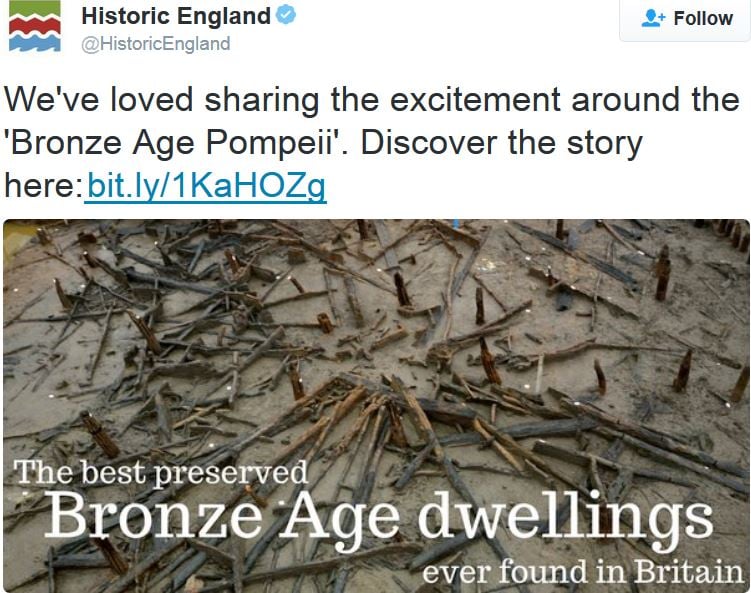British Pompeii, a Bronze Age settlement, contains some amazing artefacts and animal bones that have astonished archaeologists in Cambridgeshire. Much of the settlement, said to be from 1000 to 800 BC, has been incredibly well preserved in silt. The unearthed animal and fish bones are believed to have been the kitchen waste of the time.
The Cambridge Archaeological Unit, which is leading the excavation at Must Farm Quarry near Wittlesey, an ancient Fenland market town about six miles (10 km) from Peterborough in East Anglia, says the 3,000-year-old site is ‘unique’ and will give us a much better understanding of what Bronze Age domestic life was like in Britain.
Among the ‘amazing’ findings so far, archaeologists have discovered a tiny wooden box with its contents still inside, animal bones and an intact box – they were found in three circular wooden houses that had been propped up on stilts, and formed part of a well-to-do community.
 These beautiful beads were unearthed at the Must Farm site. Chemically, they are very similar to examples from the Balkans, which suggests they were trading over large distances, even 3,000 years ago. (Image: facebook.com/MustFarmArchaeology)
These beautiful beads were unearthed at the Must Farm site. Chemically, they are very similar to examples from the Balkans, which suggests they were trading over large distances, even 3,000 years ago. (Image: facebook.com/MustFarmArchaeology)
The Bronze Age in Britain lasted until the use of iron became common, between 800 and 650 BC. The Bronze Age seems to have coincided with an increase in the migration of people from the continent.
Bronze Age settlement was destroyed by fire
The ancient settlement was destroyed by a fire, says Historic England (called English Heritage before). During the fire, the houses fell into the river and were preserved in the clay of the riverbed.
What we have today is an incredible Pompeii-like Bronze Age time capsule full of evidence of how and where our ancient ancestors lived, including fascinating artefacts – some of the bowls discovered still have the residents’ last meals in them.
The archaeologists have unearthed rare small jars, cups, as well as textiles made from lime tree bark fibres.
Although the community was near rivers with abundant fish, the contents of the bowls suggest that the Bronze Age Britons of East Anglia preferred mutton and beef to fish.
Britain’s inhabitants at the time appear to have been considerably more sophisticated than previously thought. Several glass beads have been unearthed that formed part of an elaborate, ornamental necklace.
Better insight into Bronze Age life in Britain
The excavation team says the exposed structures are the best-preserved Bronze Age dwellings ever found in the British Isles. Together with everything else unearthed so far at the site, we now have a significantly better picture of what prehistoric life must have been like.
 Archaeologists found this small, delicate wooden box that is mostly complete. It appears to have contents preserved inside which the team has taken great care to leave in place. “We are thrilled to find an object of this quality still preserved and in very good condition,” a team member said. (Image: facebook.com/MustFarmArchaeology)
Archaeologists found this small, delicate wooden box that is mostly complete. It appears to have contents preserved inside which the team has taken great care to leave in place. “We are thrilled to find an object of this quality still preserved and in very good condition,” a team member said. (Image: facebook.com/MustFarmArchaeology)
Duncan Wilson, CEO of Historic England’s, said:
“A dramatic fire 3,000 years ago combined with subsequent waterlogged preservation has left to us a frozen moment in time, which gives us a graphic picture of life in the Bronze Age. We are learning more about the food our ancestors ate, and the pottery they used to cook and serve it.”
“We can also get an idea of how different rooms were used. This site is of international significance and its excavation really will transform our understanding of the period.”
People fled their homes in a hurry
One of the roadhouse’s well-preserved charred roof timbers are clearly visible. The site has a stakewall (also called a palisade or paling) – several wooden posts that surrounded the settlement.
According to the archaeological team, the residents fled their homes in a hurry and left their possessions behind, which was unfortunate for them but lucky for us, because everything has been amazingly well-preserved in silt. Even footprints of some of the residents have been discovered.
Forensic archaeologists are still trying to determine what caused the fire that sent the houses to the riverbed.
Excavation to continue for some months
What has been discovered so far at the Must Farm site is probably just the tip of an archaeological iceberg – a researcher’s dream come true – says the Cambridge Archaeological Unit.
 A wooden bucket/bowl being unearthed at the site. The archaeologists say that when all the items are gathered and cleaned, the Bronze Age display will be the largest in Britain and among the most impressive in the world. (Image: twitter.com/MustFarm)
A wooden bucket/bowl being unearthed at the site. The archaeologists say that when all the items are gathered and cleaned, the Bronze Age display will be the largest in Britain and among the most impressive in the world. (Image: twitter.com/MustFarm)
Over the next few months, the team expects to find more fascinating items.
After completing the dig, everything that was unearthed will be taken for further examination and conservation. All the artefacts will eventually be on display at the Peterborough Museum, as well as other venues in East Anglia.
There will also be an online resource with details of every item that was discovered, as well as a major publication about the prehistoric Bronze Age.
The excavation site is currently owned by Forterra Building Products Ltd. It sits aside a prehistoric watercourse in the Flag Fen basin.
The ancient site itself is six feet below the surface of the ground. The ground level today is much higher than it used to be three thousand years ago. The Cambridge Archaeological Unit says it has reached the riverbed as it was when the residents lived there 3,000 years ago.
Over the years, archaeologists have found several Bronze Age items at the Must Farm site. Nine pristinely-preserved log boats were discovered in 2011, and a rapier and sword in 1969.
 This diagram shows the team’s working theory on how a roundhouse collapsed into the river and the site was formed. Each element is colour-coded. (Image: twitter.com/MustFarm)
This diagram shows the team’s working theory on how a roundhouse collapsed into the river and the site was formed. Each element is colour-coded. (Image: twitter.com/MustFarm)
Excavation partners at Must Farm
Historic England and Forterra Building Products Ltd. are funding the £1.1 million project.
David Gibson, Archaeological Manager at the Cambridge Archaeological Unit, said:
“Usually at a Later Bronze Age period site you get pits, post-holes and maybe one or two really exciting metal finds. Convincing people that such places were once thriving settlements takes some imagination.”
“But this time so much more has been preserved – we can actually see everyday life during the Bronze Age in the round. It’s prehistoric archaeology in 3D with an unsurpassed finds assemblage both in terms of range and quantity.”
 Historic England shared the news of this exciting find at the beginning of this year. (Image: twitter.com/HistoricEngland)
Historic England shared the news of this exciting find at the beginning of this year. (Image: twitter.com/HistoricEngland)
Regarding the excavation site, the Cambridge Archaeological Unit wrote:
“The Must Farm project is the first landscape scale archaeological investigation of deep Fenland, with its complex geological history (from wet to dry and back again). The project’s exploration of deeply buried deposits is transforming our understanding of prehistoric life and revealing a level of preservation previously only dreamt about.”
Must Farm Archaeology (the name of the excavation team) said in Facebook that over the last few weeks it has been fortunate to receive several international visitors. Archaeologists from France and the Netherlands travelled especially to see the excavation, and a number of Japanese scientists toured the site with the Sainsbury Institute.
Must Farm Archaeology wrote:
“These visits are very important for the project as they help us to make international comparisons with Bronze Age archaeology from across Europe. This sharing of knowledge can help us to discover new interpretations and identify both similarities and differences in architecture and material culture.”
Video – Bronze Age Pompeii unearthed in East Anglia
In this video, Historian Dan Snow talks about the Must Farm site and its amazingly well-preseved Bronze Age houses.
